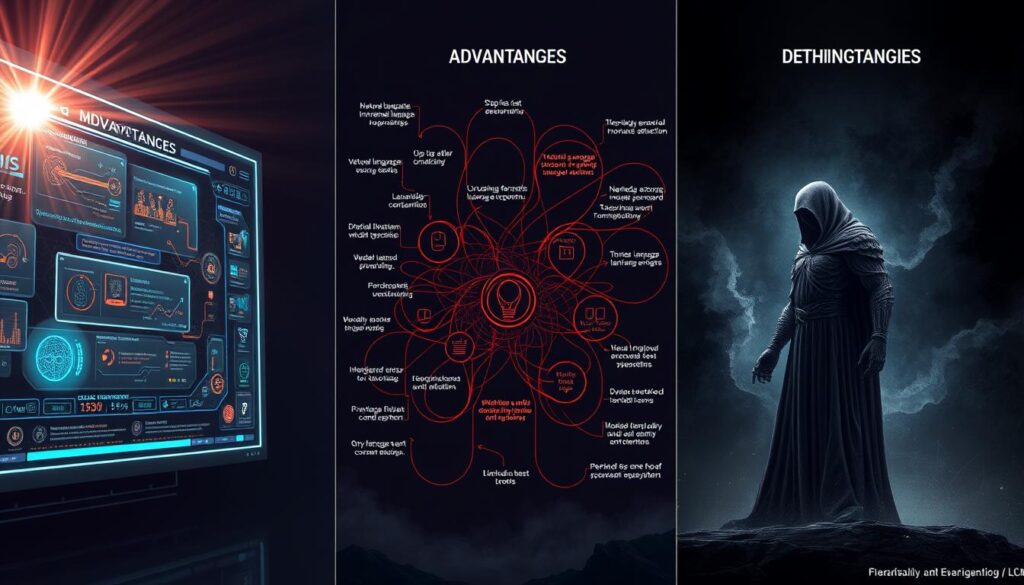Have you ever felt lost in too much information? In our digital age, making sense out of text is crucial. That’s where Large Language Models (LLMs) step in. They power many tools you use every day, like chatbots and writing aids. These advanced AI models play a key role in processing human language, changing the way we interact with technology.
As we explore together, you’ll learn how LLMs work and their amazing features. You’ll see their big impact in areas from healthcare to cybersecurity. Let’s dive into the world of LLMs and see how they combine human creativity with machine intelligence.
Key Takeaways
- Large Language Models are AI systems designed for comprehensive language understanding.
- LLMs utilize extensive textual datasets during training, reaching terabytes of data.
- Transformers are the backbone of many advanced AI language models.
- Pre-trained LLMs can perform multiple tasks without additional training.
- LLMs play a crucial role in enhancing cybersecurity by analyzing data for threats.
- The use of LLMs is projected to drive economic growth and create new job opportunities.
- Despite their advantages, LLMs also present challenges related to data quality and biases.
Introduction to Large Language Models
Large Language Models (LLMs) are a big step forward in LLM technology. They’re changing how computers and people talk to each other. Unlike older models that just predict words, these can understand and create full sentences or even whole texts. Some of the top models, like PaLM 2, have up to 340 billion parameters. This shows how powerful they can really be.
Significance of LLMs isn’t just in what tasks they can do. It’s also about making our interaction with technology better. They can summarize texts, answer questions, and sort text into categories easily. Moreover, they can identify feelings and detect harmful language, which proves their wide use.
But as LLMs get better, we also face more challenges. Bias, the need for a lot of computing power, and managing these models can be tough. Training a model can take many months and lots of resources. So, it’s important to understand these things to see how LLMs can change various industries.
What is an LLM (large language model)?
An LLM, or Large Language Model, is a smart tool for processing and making text that sounds human. It uses deep learning to get the job done. By training on immense amounts of diverse data, it grasps complicated language trends and subtleties.
Definition and Concept
LLMs are pivotal in natural language processing (NLP). They leverage a special setup called transformer architectures to digest and craft text. Thanks to enormous training data, they shine across various language tasks.
Overview of Key Features
LLMs are known for their broad and powerful features. They are stars in machine translation, condensing text, and making chatbots. Their brains, neural networks, grow smarter over time. Ongoing upgrades in LLM technology boost their precision and ability to understand context. This keeps them leading in AI innovation.

How Do LLMs Work?
Large Language Models (LLMs) use machine learning and deep learning. They understand language by analyzing huge amounts of text. These models are built on complex neural networks.
Machine Learning and Deep Learning
Machine learning is at the heart of LLMs. It uses data to improve the system’s performance. Deep learning is a type of machine learning with neural networks. It helps LLMs grasp the context and structure of language.
These networks help LLMs in writing text and translating languages.
Neural Networks and Their Structure
The main part of LLMs is neural networks. They are made of nodes in different layers. Here is a simple structure:
| Layer Type | Function |
|---|---|
| Input Layer | Accepts the incoming data for processing |
| Hidden Layers | Processes data through weighted connections, recognizing complex patterns |
| Output Layer | Generates predictions, enabling responses to language inquiries |
LLMs use a technique called self-attention to work fast. They learn and adapt faster than older models. This makes them very useful today.

Key Components of LLMs
In learning about LLMs, two key parts stand out: transformer models and tokenization. Grasping these concepts is essential. This understanding helps us see how large language models work. They play a big role in different areas.
Transformer Models
Transformer models are crucial in building LLMs. They use special methods to focus on the importance of words in context. This attention to detail allows them to process language data better. Transformer models include several types of layers. These are recurrent, feedforward, embedding, and attention layers. Such models, like OpenAI’s ChatGPT and Google’s BERT, are known for creating text that sounds like a human wrote it. They also excel in handling complicated language tasks.
Tokenization Techniques
Tokenization is key to getting text ready for LLM analysis. It breaks down text into tokens, or small, manageable pieces. Turning text into numbers, tokenization helps LLMs understand and process language. This step is crucial. It ensures LLMs can work with various kinds of language. It keeps the data true to its form.

How Are LLMs Trained?
Training large language models (LLMs) is complex and improves their skills. It includes self-supervised learning, supervised learning, and reinforcement learning. These steps help LLMs perform well in many tasks.
The Training Process Explained
The process begins with gathering huge datasets, over 1000 GB. Training models like GPT-3, which have 175 billion parameters, could take ages on one GPU. This highlights the need for distributed training.
By using multiple GPUs or TPU chips, like Google’s PaLM with 540 billion parameters, training becomes faster. Optimization algorithms help the models get better at predicting by recognizing language patterns.
Importance of Data Diversity
Data diversity is crucial for LLM effectiveness. A wide range of data helps avoid biases and allows the models to understand different contexts better. When trained with diverse datasets, LLMs grasp language and cultures more widely.
This process reduces the chance of biased responses. It makes the models more reliable in real-world use.
Fine-Tuning Models for Specific Tasks
After basic training, fine-tuning is vital for honing LLMs for certain tasks. Whether for sentiment analysis or customer service, this step increases their accuracy. Using prompt engineering and reinforcement learning, models get better while biases and errors decrease.
This fine-tuning process makes LLMs more versatile. They become more valuable in different fields.

What Are LLMs Used For?
Large Language Models (LLMs) are changing many industries. They make tasks usually done by people faster and spark new ideas in different areas. They are used in healthcare, finance, and education. By learning from lots of data, they get good at understanding and using human language.
Applications Across Various Industries
LLMs are used in many ways. Some key uses are:
- Language Translation: They help translate text between many languages, helping businesses reach more people worldwide.
- Content Creation: They make creating articles, marketing materials, emails, and more much easier.
- Data Analysis: In the finance world, LLMs help analyze data, predict trends, and support decisions.
- Customer Support: They power chatbots that offer quick help and support to customers.
Businesses use LLMs to better serve their users and keep them engaged. This makes LLMs an important part of how modern businesses work.
Benefits for Businesses and Individuals
LLMs offer big benefits by saving time. They take over routine jobs like making reports or summarizing documents. This lets you focus on bigger tasks. It leads to better use of time and higher efficiency.
LLMs also promote inclusivity. They break down communication barriers and make information easier to get. They let businesses offer more personalized service. This helps build stronger customer bonds.

Pros and Cons of LLMs
Large Language Models (LLMs) are changing the game for many sectors. They understand human language really well. This means businesses can automate boring tasks. This makes things more efficient and cuts down on manual work. Now, software development is smoother because LLMs adapt through all stages. They also allow for quick testing of new code. This sparks more innovation, as teams can try many ideas quickly.
But, LLMs have downsides too. They might give out wrong or unreliable info. That can mess with making good decisions. Sometimes, what they produce has to be double-checked. This can slow things down, undoing some of their benefits. Also, they raise big concerns about ethics, like privacy issues. If sensitive info is used, security risks go up. This shows the importance of being careful with data. Plus, any unfairness in their training data might show up in their results. This brings up concerns about fairness and being responsible.
Also, LLMs need a lot of computing power and data. This can be tough for smaller groups to handle. They’re complex and require ongoing investment in tech and skilled people. To really benefit from LLMs while avoiding pitfalls, careful planning is key. This means balancing innovation with being ethical.
| Advantages of LLMs | Disadvantages of LLMs | Ethical Concerns LLMs |
|---|---|---|
| Enhanced natural language understanding | Producing inaccurate outputs | Data privacy risks |
| Automation of repetitive tasks | High computational costs | Biases in training data |
| Support for rapid code prototyping | Need for user verification | Lack of transparency in outputs |
| Scalability in processing documents | Requires significant resources | Dependence on training data |

LLMs in Cybersecurity
Using LLMs in cybersecurity greatly improves how we detect and respond to threats. These systems, like OpenAI’s GPT-4, have over 170 trillion parameters. They can sift through tons of data from websites, books, and articles. This means they can spot tricky signs of cyber attacks in emails and social posts, making our digital walls stronger against advanced enemies.
LLMs make it easier to handle repetitive work in Security Operations Centers. They write scripts for usual incident responses, letting you make bigger, strategic decisions. Also, they’re great at finding patterns from serious cyber threats, improving our security tactics.
Yet, using LLMs comes with its own dangers we can’t ignore. Things like being overwhelmed by fake input or bad training data are real risks. The OWASP Top Ten for LLMs points out threats including tricking the system and leaking private info. By adopting strict data rules and always updating our methods, we make sure LLMs work well and safely in the face of new challenges.









